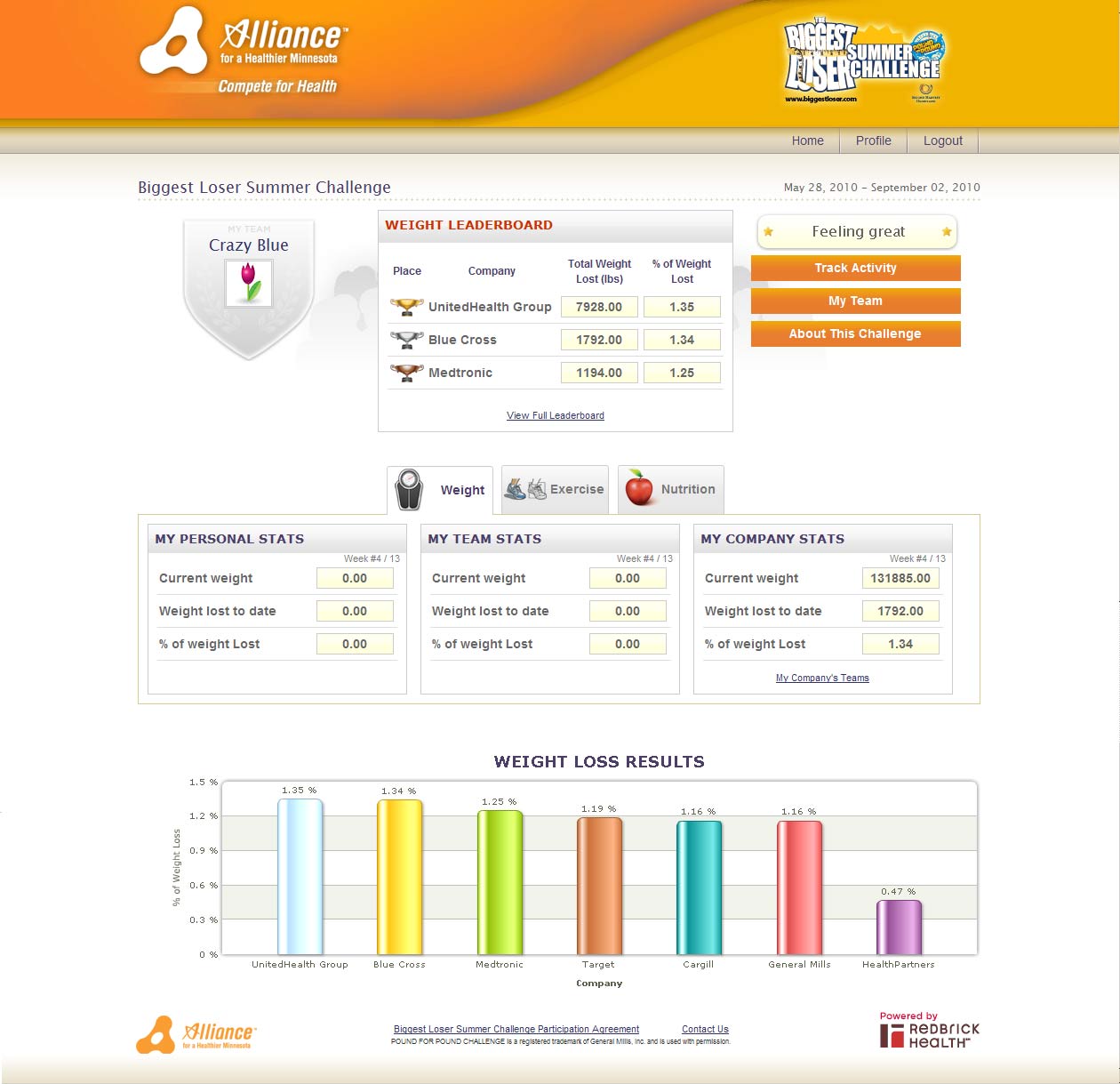Entries in Social Health Community (19)
“Biggest Loser” Employees, Multi-Company Challenge Uses Social Networking to Drive Motivation
 June 28, 2010
June 28, 2010  Alliance for a Healthier Minnesota launched an online health and wellness competition with teams from large local employers including General Mills, Target, BCBS Minnesota and UnitedHealth Group. Employees are battling in three contests; to lose weight, be more active and eat healthier. Weight loss is center stage. In four weeks since the Challenge started, 10,000 employees have lost over 20,000 pounds.
Alliance for a Healthier Minnesota launched an online health and wellness competition with teams from large local employers including General Mills, Target, BCBS Minnesota and UnitedHealth Group. Employees are battling in three contests; to lose weight, be more active and eat healthier. Weight loss is center stage. In four weeks since the Challenge started, 10,000 employees have lost over 20,000 pounds.
Powering the Challenge
RedBrick Health’s Platform enables companies and their employees to engage in this competition through social networking, messaging, tracking and monitoring capabilities. As a first step, employees use their online tools to build their teams. Each employee contributes to his team by earning points for losing weight, engaging in physical activity (minutes) and following nutritional guidelines. Most employees recorded their results online. Although they can also enter their weight through their mobile phone. Employees closely watch the “leader board” on CompeteforHealth.org to monitor their progress.
As the Challenge heats up, employees turn their attention to their own physical activity and dietary decisions and post messages for their social network of team and company participants. In fact, there are thousands of posts already shared between teammates. The types of messages fall into seven different categories:
1. Goal Setting - I plan to lose three pounds to get to my ideal BMI. I will not eat desserts at the wedding this weekend. I am going to exercise five times a week.
2. Motivating - You can do it! Our Team is going to rock!
3. Praising - Congratulations on finishing the 5K! I knew you could make it the entire conference without eating a cookie! Thanks for bringing us all a healthy lunch!
4. Reminding - Don't forget to track your weight! Remember to join our team at the walking path this afternoon. Sign up for our Team by Monday!
5. Inviting - Who wants to join a softball team? Anyone want to sign-up for the half-marathon? Who wants to join me in losing five pounds over the next month?
6. Sharing (with links provided)- Have you seen these core exercises? Take a look at this marathon website. Try this new low fat dessert recipe.
7. Slipping-up - I fell off the wagon this weekend and ate poorly... I'll turn it around this week. I skipped exercising the past few days...I plan to restart tomorrow...sorry team.
There are several themes running through these team messages of camaraderie, accountability and support.
Extra Push from Multi-Company Challenges
“Although companies find different motivations for their specific populations, we do believe the multi-company competition is generating even greater engagement than a single company competition”, explains Eric Zimmerman, Chief Marketing Officer at RedBrick Health. “The differentiator is the additional leadership push we’re seeing in the multi-company competition. There’s a great deal of company pride at stake, especially when you have a public leader board posting your organization's progress versus your peers.”
Hear more about these social competitions taking place across and within employer organizations from Eric Zimmerman at the Healthcare Unbound Conference on my panel New Models for Leveraging Social Media for Consumer Engagement.
New Models for Leveraging Social Media for Consumer Engagement
 May 20, 2010
May 20, 2010
 Healthcare Unbound Conference Panel, San Diego, CA July 19th
Healthcare Unbound Conference Panel, San Diego, CA July 19th
Leaders in the healthcare industry are using social media in entertaining, educational and emotional ways to engage and empower the consumer.
Research has shown the cost savings resulting from consumers' use of social media to support each other. Consumers experience less depression and isolation as they navigate their own health issues. However, social media has moved beyond support to motivate consumers in new, exciting and very personal ways which will be measured through “social analytics”.
Where are we headed with social media and how are these leaders planning to get there?
During this panel, you will see and hear about examples:
- Social Media designed to attract and motivate specific consumer “segments” such as teens, seniors, caregivers, employees and patients
- Social Media intervention developed by teens for teens
- Gaming and social networks with competitions and rewards for healthy behaviors
- Differentiated “private” and “public” social media initiatives which span business goals
- New framework for generating consumer engagement incorporating financial, social and personal dimensions
Panel Moderator: Sherri Dorfman, MBA, Consumer Engagement Specialist, CEO, Stepping Stone Partners
- Paul Puopolo, Director, Consumer Innovation, Humana
- Eric Zimmerman, Chief Marketing Officer, RedBrick Health
- Rick LeMoine, MD, FACP, Chief Medical Information Officer, Sharp HealthCare
- Paul To, CEO & Founder, Emota.net
- Kendra Markle, Stanford Persuasive Technology Lab, AlterActions.org
"You Don't Know Jack"... Missed Opportunities to Engage Him
 May 3, 2010
May 3, 2010 
Let me tell you about Jack…
Last week, Jack celebrated his 54th birthday with his wife and two teenage girls. His daughter Alyssa told him to "try not to finish the cake when no one is looking”. Jack has packed on the pounds in the past few years and is currently 60+ pounds overweight. Alyssa teased her father about how many miles he will need to bike to work off the extra slices. Jack’s wife Joan is concerned since she knows that he is at risk for Diabetes.
Several months ago Jack complained to his doctor that he was disgusted with his weight and was ready to make a change. Over the last few years, Jack tried several diets but he still doesn't make the right dietary decisions. Jack told his doctor that he was considering bariatric surgery and asked for a referral to meet with a surgeon. Maybe his doctor could have “prescribed information” for Jack such as watching a video on a weight loss approach which has been successful for others like Jack or signing up for a eNewsletter with tips to control his weight through diet and exercise from a "trusted source".
Jack’s Health Plan is after him to participate in their Pre- Diabetes Program but Jack would rather focus on other health issues. Jack can’t stop thinking about the bariatric surgery. He is worried about taking such a big step but does not know about other less invasive options. Jack is not aware of the “decision support tools” that his health plan has online since he has not been to the member portal in years. He also ignores the mass produced print and eNewsletters since they do not address his specific interests. He had to contact this health plan to obtain the referral to the specialist but has not received any information from them which will help him understand his options.
Jack’s employer launched a wellness incentive program with weekly on-site challenges offering rewards for his “steps”. Unfortunately, Jack travels frequently and misses these competitions. He bikes on weekends but that is not part of his employer’s wellness incentive program.
When he has time, Jack visits an online community of people interested in weight loss. Too bad this website does not have a sub-community of business travelers since this “segment” has the same challenges with eating out every meal and having limited time to work out.
There are many opportunities to step in to educate, engage and motivate Jack to follow the path to better health. What can you do to get to know and help Jack?
Series: Engagement Path #2- Support Me
 April 5, 2010
April 5, 2010 
As social media explodes in healthcare, companies are launching new communities and communication tools to connect consumers with each other and with experts. Research has shown that consumers value learning about and from the experiences of others and receiving emotional support.
Healthcare organizations are building online support communities combined with social media tools, enabling consumers to connect with friends and strangers to share a common bond. Consumers are responding by visiting their channel on YouTube to upload a video about their personal experiences or sharing a comment about a video that moved them. They are on Facebook leaving their “thumbs up” when they like what they see. Consumers are there (virtually) with words of support for those newly diagnosed and those experiencing set- backs.
“I am scared because my child is having problems managing his diabetes at school and I don’t know what to do”.
"My MS is getting worse. I am frightened to speak with others who are further along but would like to reach out to those who are experiencing what I am right now.”
“My family is getting the brunt of my frustrations and I feel terrible.”
“Support Me” Opportunity: Provide the capability to share encouragement, validation and an emotional connection with other people and experts.
Engagement in Action:
These innovative organizations are offering consumers the capabilities to demonstrate their support online.
- Livestrong Facebook community has over 700,000 fans. Community members are extremely engaged posting pictures and comments about their most personal experiences on this very public site. Unlike many communities which have a more limited response, Livestrong is a vibrant community with hundreds of posts sharing thoughts and endless support. Livestrong also engages their community off line through events, further connecting and building bonds between their members.
- TuDiabetes ran a Making Sense of Diabetes program leading up to World Diabetes Day. Members uploaded videos sharing their experiences living with diabetes on a daily basis. Many of these videos received high ratings from the community and comments were shared showing support.
- AARP has launched LifeTuners, an online community for young adults (20s and 30s) offering “unbiased, balanced resources, information and financial advice”. Within the community, consumers are accessing advice and support from experts and their peers and rating the recommendations they read. AARP has built this support community to educate young people about the things they can do now that will impact their future. Notice the parallels with wealth and health.
- MDJunction offers an online community with the ability to share different types of visual messages such as “a hug”, “a cheer up”, “a happy for you”, “a prayer” and “a salute”. Community members can also display one or more than a dozen different color ribbons showing their support from gray for Juvenile Diabetes to black for Melanoma Cancer.
Healthcare companies need to move beyond the basics of setting up different social media destinations and envision integrated offerings that enable consumers to care for one another anytime and anywhere, through online and mobile. They also need to determine the role that the “expert” plays to support and strengthen the community.


